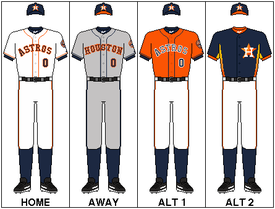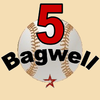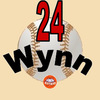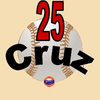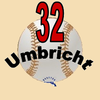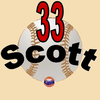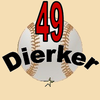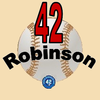Houston Astros
| Houston Astros | |||||
|---|---|---|---|---|---|
| | |||||
| Established | 1962 | ||||
| |||||
| Major league affiliations | |||||
| |||||
| Current uniform | |||||
| |||||
| Retired numbers | 5 · 7 · 24 · 25 · 32 · 33 · 34 · 40 · 42 · 49 | ||||
| Colors | |||||
| |||||
| Name | |||||
| |||||
| Other nicknames | |||||
| |||||
| Ballpark | |||||
| |||||
| Major league titles | |||||
| World Series titles (0) | |||||
| NL Pennants (1) | 2005 | ||||
| NL Central Division titles (4) | 2001 · 1999 · 1998 · 1997 | ||||
| NL West Division titles (2) | 1986 · 1980 | ||||
| Wild card berths (2) | 2005 · 2004 | ||||
| Front office | |||||
| Owner(s) | Jim Crane | ||||
| Manager | Bo Porter | ||||
| General Manager | Jeff Luhnow | ||||
| President of Baseball Operations | Reid Ryan | ||||
The Houston Astros are a professional baseball team located in Houston, Texas. The team is a member of the Western Division of Major League Baseball's American League, having moved in 2013 after spending their first 51 seasons in the National League.[1] The Astros have played their home games at Minute Maid Park since 2000.[2]
The Astros were established as the Houston Colt .45s in 1962. The current name was adopted three years later when they moved into the Astrodome, the world's first domed sports stadium. The name reflects Houston's role as the center of the U.S. Space Program.
The Astros have one World Series appearance, in 2005 against the Chicago White Sox, where they lost.
Franchise history
Major League Baseball comes to Texas
From 1888 until 1961, Houston's professional baseball club was the minor league Houston Buffaloes. Although expansion from the National League eventually brought a Major League team to Texas in 1962, Houston officials had been making efforts to do so for years prior.[3] There were four men chiefly responsible for bringing Major League Baseball to Houston: George Kirksey and Craig Cullinan, who had led a futile attempt to purchase the St. Louis Cardinals in 1952; R.E. "Bob" Smith, a prominent oilman and real estate magnate in Houston who was brought in for his financial resources; and Judge Roy Hofheinz, a former Mayor of Houston and Harris County Judge who was recruited for his salesmanship and political style. They formed the Houston Sports Association as their vehicle for attaining a big league franchise for the city of Houston.[4]
Given MLB's refusal to consider expansion, Kirksey, Cullinan, Smith, and Hofheinz joined forces with would-be owners from other cities and announced the formation of a new league to compete with the established National and American Leagues. They called the new league the Continental League. Wanting to protect potential new markets, both existing leagues chose to expand from eight teams to ten. However, plans eventually fell through for the Houston franchise after the Houston Buffaloes owner, Marty Marion, could not come to an agreement with the HSA to sell the team.[5] To make matters worse, the Continental League as a whole folded in August 1960.
However, on October 17, 1960, the National League granted an expansion franchise to the Houston Sports Association in which their team could begin play in the 1962 season. According to the Major League Baseball Constitution, the Houston Sports Association was required to obtain territorial rights from the Houston Buffaloes in order to play in the Houston area, and again negotiations began to purchase the team.[6][7] Eventually, the Houston Sports Association succeeded in purchasing the Houston Buffaloes, at this point majority-owned by William Hopkins, on January 17, 1961.[8] The Buffs played one last minor league season as the top farm team of the Chicago Cubs in 1961 before being succeeded by the city's NL club.
The new Houston team was named the Colt .45s after a "Name The Team" contest was won by William Irving Neder. The Colt .45 was well known as "the gun that won the west."[9] The colors selected were navy blue and orange. The first team was a group of scrubs formed mostly through an expansion draft after the 1961 season. The Colt .45s and their expansion cousins, the New York Mets, took turns choosing players left unprotected by the other National League franchises.
Many of those associated with the Houston Buffaloes organization were allowed by the ownership to continue in the major league. Manager Harry Craft, who had joined Houston in 1961, remained in the same position for the team until the end of the 1964 season. General manager Spec Richardson also continued with the organization as business manager, but was later promoted again to the same position with the Astros from 1967 until 1975. Although most players for the major league franchise were obtained through the 1961 Major League Baseball expansion draft, Buffs players J.C. Hartman, Pidge Browne, Jim Campbell, Ron Davis, Dave Giusti, and Dave Roberts were chosen to continue as major league ball players.
Similarly, the radio broadcasting team remained with the new Houston major league franchise. Loel Passe worked alongside Gene Elston as a color commentator until he retired from broadcasting in 1976. Elston continued with the Astros until 1986.
The Colt .45s began their existence playing at Colt Stadium. Colt Stadium, however, was just a temporary field until Judge Hofheinz could build an indoor stadium.
1962–1964: The Colt .45s
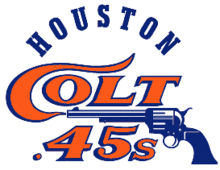
The Colt .45s started their inaugural season on April 10, 1962, against the Chicago Cubs with Harry Craft as the Colt .45s' manager. Bob Aspromonte scored the first run for the Colt .45s on an Al Spangler triple in the first inning.[10] They started the season with a three-game sweep of the Cubs but eventually finished eighth among the National League's ten teams. The team's best pitcher, Richard "Turk" Farrell, lost 20 games despite an ERA of 3.02. A starter for the Colt .45s, Farrell was primarily a relief pitcher prior to playing for Houston. He was selected to both All-Star Games in 1962.[11]
The 1963 season saw more young talent mixed with seasoned veterans. Jimmy Wynn, Rusty Staub, and Joe Morgan all made their major league debuts in the 1963 season. However, Houston's position in the standings did not improve. In fact, the Colt .45s finished in ninth place with a 66–96 record. The team was still building, trying to find that perfect mix to compete.[4] The 1964 campaign began on a sad note. Pitcher Jim Umbricht died of cancer at the age of 33 just before Opening Day. Umbricht was the only Colt .45s pitcher to post a winning record in Houston's first two seasons. He was so well liked by players and fans that the team retired his jersey number, 32, in 1965.[12]
Just on the horizon, the structure of the new domed stadium was more prevalent and it would soon change the way that baseball was watched in Houston and around the league.
1965–1970: The Great Indoors
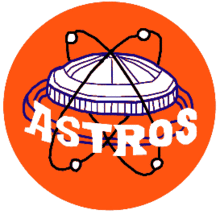
With Judge Roy Hofheinz now the sole owner of the franchise and the new venue complete, the Colt .45s moved into their new domed stadium, the Astrodome, in 1965. The name honored Houston's position as location of the nation's space program. The Colt .45s were renamed the Astros.[13] The new park, coined the "Eighth Wonder of the World", did little to help the play on the field. While several "indoor" firsts were accomplished, the team still finished ninth in the standings. The attendance was high not because of the team accomplishments, but because people came from miles around to see the Astrodome.
Just as the excitement was settling down over the Astrodome, the 1966 season found something new to put the domed stadium in the spotlight once again – the field. Grass would not grow in the new park, since the roof panels had been painted to reduce the glare that was causing players on both the Astros and the visiting teams to miss routine pop flies. A new artificial turf was created called "AstroTurf" and Houston would be involved in yet another change in the way the game was played.[14]
With new manager Grady Hatton the Astros started the 1966 season strong. By May they were in second place in the National League and looked like a team that could contend. Joe Morgan was named as a starter on the All-Star Team. The success did not last as they lost Jimmy Wynn for the season after he crashed into an outfield fence in Philadelphia and Morgan had broken his knee cap.[4] 1967 saw first baseman Eddie Mathews join the Astros. The slugger hit his 500th home run while in Houston. He would be traded late in the season and Doug Rader would be promoted to the big leagues. Rookie Wilson pitched a no-hitter on June 18, the first pitched in team history. Wynn also provided some enthusiasm in 1967. The 5 ft 9 in Wynn was becoming known not only for how often he hit home runs, but also for how far he hit them. Wynn set club records with 37 home runs, and 107 RBIs. It was also in 1967 that Wynn hit his famous home run onto Interstate 75 in Cincinnati.[15] As the season came to a close, the Astros found themselves again in ninth place and with a winning percentage below .500. The team looked good on paper, but could not make it work on the field.
April 15, 1968 saw a pitching duel for the ages. The Astros' Don Wilson and the Mets' Tom Seaver faced each other in a pitching duel that lasted six hours. Seaver went ten innings, allowing no walks and just two hits. Wilson went nine innings, allowing five hits and three walks. After the starters exited, eleven relievers (seven for the Mets and four for the Astros) tried to end the game. The game finally ended in the 24th inning when Aspromonte hit a shot toward Mets shortstop Al Weis. Weis had been perfect all night at short, but he was not quick enough to make the play. The ball zipped into left field, allowing Norm Miller to score.[16]
With baseball expansion and trades, the Astros had dramatically changed in 1969. Aspromonte was sent to the Braves and Staub was traded to the expansion Montreal Expos, in exchange for outfielder Jesus Alou and first baseman Donn Clendenon. However, Clendenon refused to report to Houston, electing to retire and take job with a pen manufacturing company. The Astros asked Commissioner Bowie Kuhn to void the trade, but he refused. Instead, he awarded Jack Billingham and a left-handed relief pitcher to the Astros to complete the trade. Cuellar was traded to the Baltimore Orioles for Kurt Blefary. Other new players included catcher Johnny Edwards, infielder Denis Menke, and pitcher Denny Lemaster. Wilson continued to pitch brilliantly and on May 1 threw the second no-hitter of his career. In that game, he struck out 18 batters, tying what was then the all-time single-game mark. He was just 24 years of age and was second to only Sandy Koufax for career no-hit wins. Wilson's no-hitter lit the Astros' fire after a miserable month of April, and six days later the team tied a major league record by turning seven double plays in a game. By May's end the Astros had put together a ten-game winning streak. The Houston infield tandem of Menke and Joe Morgan continued to improve, providing power at the plate and great defense. Morgan had 15 homers and stole 49 bases while Menke led the Astros with 90 RBIs. The Menke/Morgan punch was beginning to come alive, and the team was responding to Walker's management style. The Astros dominated the season series against their expansion twins, the New York Mets, that season. In one game at New York, Denis Menke and Jimmy Wynn hit grand slams in the same inning, against a Mets team that would go on to win the World Series that same year. The Astros finished the 1969 season with a record of 81 wins, 81 losses, marking their first season of .500 ball.
In 1970, the Astros were expected to be a serious threat in the National League West. In June, 19-year-old César Cedeño was called up and immediately showed signs of being a superstar. The Dominican outfielder batted .310 after being called up. Not to be outdone, Denis Menke batted .304 and Jesús Alou batted .306. The Astros' batting average was up by 19 points compared to the season before.[15][17] The team looked good, but the Astros' ERA was up. Larry Dierker and Don Wilson had winning records, but the pitching staff as a whole had an off season. Houston finished in fourth place in 1970.
1971–1974: The boys in orange
The fashion trends of the 1960s had started taking root in baseball. Long hair and loud colors were starting to appear on team uniforms, including the Astros'. In 1971 the Astros made some changes to their uniform: they kept the same style they had in previous seasons, but inverted the colors. What was navy blue was now orange and what was orange was now a lighter shade of blue. The players' last names were added to the back of the jerseys. In 1972, the uniform fabric was also changed to what was at the time revolutionizing the industry – polyester. Belts were replaced by elastic waistbands, and jerseys zipped up instead of having buttons. The uniforms became popular with fans, but would last only until 1975, when the Astros would shock baseball and the fashion world.[18]
The uniforms were about the only thing that did change in 1971. The acquisition of Roger Metzger from the Chicago Cubs in the off-season moved Menke to first base and Bob Watson to the outfield. The Astros got off to a slow start and the pitching and hitting averages were down. Larry Dierker was selected to the All-Star game in 1971, but due to an arm injury he could not make it. César Cedeño led the club with 81 RBIs and the league with 40 doubles, but batted just .264 and had 102 strikeouts in his second season with the Astros.[19] Pitcher J. R. Richard made his debut in September of the 1971 season against the Giants.
The big trade
In November 1971 the Astros and Cincinnati Reds made one of the most blockbuster trades in the history of the sport,[20] and helped create The Big Red Machine of the 1970s,[21] with the Reds getting the better end of the deal. Houston sent second baseman Joe Morgan, infielder Denis Menke, pitcher Jack Billingham, outfielder César Gerónimo and prospect Ed Armbrister to Cincinnati for first baseman Lee May, second baseman Tommy Helms and infielder Jimmy Stewart. The trade left Astros fans and the baseball world scratching their heads as to why General Manager Spec Richardson would give up so much for so little. The Reds, on the other hand, would shore up many problems. They had an off year in 1971, but were the National League Pennant winner in 1972.[20]
The Astros' acquisition of Lee May added more power to the lineup in 1972. May, Wynn, Rader and Cedeño all had 20 or more home runs and Watson hit 16. Cedeño also led the Astros with a .320 batting average, 55 stolen bases and made spectacular plays on the field. Cedeño made his first All-Star game in 1972 and became the first Astros player in team history to hit for the cycle in August versus the Reds. The Astros finished the strike-shortened season at 84-69, their first winning season.[4]
Astros fans had hoped for more of the same in 1973, but it was not to be. The Astros run production was down, even though the same five sluggers the year before were still punching the ball out of the park. Lee May led the Astros with 28 home runs and Cesar Cedeño batted .320 with 25 home runs. Bob Watson hit the .312 mark and drove in 94 runs. Doug Rader and Jimmy Wynn both had 20 or more home runs. However, injuries to their pitching staff limited the Astros to an 82–80 fourth-place finish. The Astros again finished in fourth place the next year under new manager Preston Gómez.[4][22]
1975–1979: The rainbow era
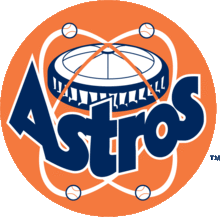
With the $38 million deficit of the Astrodome, control of the Astrodomain was passed from Judge Roy Hofheinz to GE Credit and Ford Motor Credit. This included the Astros. The creditors were just interested in preserving asset value of the team, so any money spent had to be found or saved somewhere else.[23] Tal Smith returned to the Astros from the New York Yankees to find a team that needed a lot of work and did not have a lot of money. However, there would be some bright spots that would prove to be good investments in the near future.
The year started on a sad note. Pitcher Don Wilson was found dead in the passenger seat of his car on January 5, 1975. Cause of death was asphyxiation by carbon monoxide. Wilson was 29 years old. Wilson's number 40 was retired on April 13, 1975.[18]
The 1975 season saw the introduction of the Astros' new uniforms. Many teams were going away from the traditional uniform and the Astros were no exception. The uniforms had multishade stripes of orange, red and yellow in front and in back behind a large dark blue star over the midsection. The same stripes run down the pant legs. Players numbers not only appeared on the back of the jersey, but also on the pant leg. The bright stripes were meant to appear as a fiery trail like a rocket sweeping across the heavens. The uniforms were panned by critics, but the public liked them and versions started appearing at the high school and little league level. The uniform was so different from what other teams wore that the Astros wore it both at home and on the road until 1980.[18]
Besides the bright new uniforms there were some other changes. Lee May was traded to Baltimore for much talked about rookie second baseman Rob Andrews and utility player Enos Cabell. In Baltimore, Cabell was stuck behind third baseman Brooks Robinson, but he took advantage of his opportunity in Houston and became their everyday third baseman.[24] Cabell would go on to become a big part of the team's success in later years. With May gone, Bob Watson was able to move to first base and was a bright spot in the line up, batting .324 with 85 RBI.
The two biggest moves the Astros made in the offseason were the acquisitions of Joe Niekro and José Cruz. The Astros bought Niekro from the Braves for almost nothing. Niekro had bounced around the big leagues with minimal success. His older brother Phil Niekro had started teaching Joe how to throw his knuckleball and Joe was just starting to use it when he came to the Astros. Niekro won six games, saved four games and had an ERA of 3.07.[25] José Cruz was also a steal, in retrospect, from the Cardinals.[26] Cruz became a fixture in the Astros' outfield for several years and would eventually have his number 25 retired.
Despite high expectations, 1975 was among the Astros' worst in franchise history. Their record of 64–97 was far worse than even the expansion Colt .45's, but not as bad as the 2011 Astros (56–106) and the 2012 Astros (55–107). It was the worst record in baseball and manager Preston Gómez was fired late in the season and replaced by Bill Virdon. The Astros played .500 ball under Virdon in the last 34 games of the season.[18] With Virdon as the manager the Astros improved greatly in 1976 finishing in third place with an 80–82 record. A healthy César Cedeño was a key reason for the Astros' success in 1976. Bob Watson continued to show consistency and led the club with a .313 average and 102 RBI. José Cruz became Houston's everyday left fielder and hit .303 with 28 stolen bases.[27][28] 1976 saw the end of Larry Dierker's playing career as an Astro, but before it was all over he would throw a no-hitter and win the 1,000th game in the Astrodome.[29] The Astros finished in third place again in 1977 with a record of 81–81.[18]
One of the big problems the Astros had in the late 1970s was that they were unable to compete in the free agent market. Ford Motor Credit Company was still in control of the team and was looking to sell the Astros, but they were not going to spend money on better players. Most of the talent was either farm grown or bought on the cheap.
The 1979 season would prove to be a big turnaround in Astros history. During the offseason, the Astros made an effort to fix some of their problem areas. They traded Floyd Bannister to Seattle for shortstop Craig Reynolds and acquired catcher Alan Ashby from Toronto for pitcher Mark Lemongello. Reynolds and Ashby were both solid in their positions and gave Houston some much needed consistency.[30] The season started with a boost from pitcher Ken Forsch, who threw a no-hitter the Braves the second game of the season.[18] In May 1979, New Jersey shipping tycoon Dr. John McMullen had agreed to buy the Astros. Now with an investor in charge, the Astros would be more likely to compete in the free agent market.[31]
The Astros were playing great baseball throughout the season. José Cruz and Enos Cabell both stole 30 bases. Joe Niekro had a great year with 21 wins and 3.00 ERA. J. R. Richard won 18 games and set a new personal strikeout record at 313. Joe Sambito came into his own with 22 saves as the Astros closer. Things were going as they should for a team that could win the west.[18] The Astros and Reds battled the final month of the season. The Reds pulled ahead of the Astros by a game and a half. Later that month they split a pair and the Reds kept the lead. That would be how it would end. The Astros finished with their best record to that point at 89–73 and 1½ games behind the NL winner Reds.[18]
With Dr. McMullen as sole owner of the Astros, the team would now benefit in ways a corporation could not give them. The rumors of the Astros moving out of Houston started to crumble and the Astros were now able to compete in the free-agent market. McMullen showed the city of Houston that he too wanted a winning team, signing nearby Alvin, Texas native Nolan Ryan to the first million-dollar-a-year deal. Ryan had four career no-hitters already and had struck out 383 in one season.[18]
1980: On the brink
Joe Morgan, who regretted leaving the Astros,[32] returned in 1980. Now back in Houston with two MVP awards and two World Series rings, Morgan wanted to help make the Astros a pennant winner.
1980 saw one of the best pitching lineups the Astros ever had, with the fastball of Ryan, the knuckleball of Joe Niekro and the terrifying 6 ft 8 in frame of J. R. Richard. Teams felt lucky to face Ken Forsch, who was a double-digit winner in the previous two seasons. Richard became the first Astros pitcher to start an All-Star game. After a medical examination three days later, Richard was told to rest his arm and he collapsed during a July 30 workout. He had suffered a stroke after a blood clot in the arm apparently moved to his neck and cut off blood flow to the brain. Surgery was done to save his life, but the Astros had lost their ace pitcher after a 10–4 start with a stingy 1.89 ERA. Richard attempted a comeback, but would never again pitch a big league game.[18][33]
After the loss of Richard and some offensive struggles, the Astros slipped to third place in the division behind the Dodgers and the Reds. They bounced back to first with a ten-game winning streak, but the Dodgers had regained a two-game lead when they arrived in Houston on September 9. The Astros won the first two games of that series and the two teams were tied for the division lead. The Astros held a three game lead over the Dodgers with three games left in the season against the Dodgers. The Dodgers swept the series games, forcing a one-game playoff the next day.[34] The Astros would however win the one-game playoff 7-1, and advance to their first post-season.
The team would face the Philadelphia Phillies in the 1980 National League Championship Series. The Phillies sent out Steve Carlton in game one of the NLCS after a six-hour flight the night before.[18][35] The Phillies would win the opener after the Astros got out to a 1-0 third-inning lead. Ken Forsch pitched particularly strong fourth and fifth innings, but Greg Luzinski hit a sixth-inning two-run bomb to the 300 level seats of Veterans Stadium. The Phillies added an insurance run on the way to a 3–1 win.[4] Houston bounced back to win games two and three. Game four went into extra innings, with the Phillies taking the lead and the win in the tenth inning. Pete Rose started a rally with a one-out single, then Luzinski doubled off the left field wall and Rose bowled over catcher Bruce Bochy to score the go-ahead run. The Phillies got an insurance run on the way to tying the series.[4]
Rookie Phillies pitcher Marty Bystrom was sent out by Philadelphia manager Dallas Green to face veteran Nolan Ryan in Game Five. The rookie gave up a run in the first inning, then held the Astros at bay until the sixth inning. An Astros lead was lost when Bob Boone hit a two-out single in the second, but the Astros tied the game in the sixth with an Alan Ashby single scoring Denny Walling. Houston took a 5–2 lead in the seventh, however the Phillies came back with five runs in the inning. The Astros came back against Tug McGraw with four singles and two two-out runs. Now in extra innings, Garry Maddox doubled in Del Unser with one out to give the Phillies an 8–7 lead. The Astros failed to score in the bottom of the tenth.[4][36]
It must be noted that Howard Cosell was announcing the play by play on TV, and the fans in the Astrodome were so loud in their chant of "Hou..Ston..As...tros", that the TV cameras literally shook to the beat and Cosell could not hear himself speak. Cosell was not pleased.
At the beginning of the series with the Phillies, KILT AM radio announced that the Astros number one fan “Astroman” would live on top of the Domed Stadium and would not come down until the Astros won the World Series. Over the next 10 days Astroman, played by KILT salesman Denver Griffith lived on top of the Astrodome in a six man tent. On top of the Astrodome was also a telephone hot line back to KILT radio where Griffith as Astroman would give interviews throughout the day. Astroman was completely cut off and could only get food and drink by lowering a rope with a basket the 18 stories from the top of the Astrodome to the center of the playing field. At one point Griffith got so desperate for food and drink that his mother had to intervene and interrupt an Oilers practice so that the needed supplies could be delivered. Every night a local TV station would sign off with a shot of Astroman on top of the Astrodome waving to a circling news chopper.
1981–1985
A 1981 player strike ran between June 12 and August 10. Ultimately, the strike would help the Astros get into the playoffs. Nolan Ryan and Bob Knepper picked up steam in the second half of the season. Ryan threw his fifth no-hitter on September 26 and finished the season with a 1.69 ERA. Knepper finished with an ERA of 2.18.[4] In the wake of the strike, Major League Baseball took the winners of each "half" season and set up a best-of-five divisional playoff. The Reds won more games than any other team in the National League, but they won neither half of the strike-divided season. The Astros finished 61–49 overall, which would have been third in the division behind the Reds and the Dodgers. Advancing to the playoffs as winners of the second half, Houston beat Los Angeles in their first two playoff games at home, but the Dodgers took the next three in Los Angeles to advance to the NLCS.
By 1982, only four players and three starting pitchers remained from the 1980 squad. The Astros were out of pennant contention by August and began rebuilding for the near future. Bill Virdon was fired as manager and replaced by original Colt .45 Bob Lillis. Don Sutton asked to be traded and was sent to the Milwaukee Brewers for cash and the team gained three new prospects, including Kevin Bass. Minor league player Bill Doran was called up in September. Bass also got a look in the outfield. The Astros finished fourth in the west, but new talent was starting to appear.[4]
Before the 1983 season, the Astros traded Danny Heep to the Mets for pitcher Mike Scott, a 28-year-old who had struggled with New York. Art Howe sat out the 1983 season with an injury, forcing Phil Garner to third and Ray Knight to first. Doran took over at second, becoming the everyday second baseman for the next seven seasons.[37] The Astros finished third in the National League West.[4] The 1984 season started off badly when shortstop Dickie Thon was hit in the head by a pitch and was lost for the season. In September, the Astros called up rookie Glenn Davis after he posted impressive numbers in AAA. The Astros finished in second place. In 1985, Mike Scott learned a new pitch, the split-finger fastball. Scott, who was coming off of a 5–11 season, had found his new pitch and would become one of Houston's most celebrated hurlers. In June, Davis made the starting lineup at first base, adding power to the team. In September, Joe Niekro was traded to the Yankees for two minor league pitchers and lefty Jim Deshaies. The Astros finished in fourth place in 1985.[4]
1986: Lighting a fire
After finishing fourth in 1985 the Astros fired general manager Al Rosen and manager Bob Lillis. The former was supplanted by Dick Wagner, the man whose Reds defeated the Astros to win the 1979 NL West title. The latter was replaced by Hal Lanier who, like his manager mentor in St. Louis, Whitey Herzog, had a hard-nosed approach to managing and espoused a playing style that focused on pitching, defense, and speed rather than home runs to win games. This style of baseball, known as Whiteyball, took advantage of stadiums with deep fences and artificial turf, both of which were characteristics of the Astrodome. Lanier's style of baseball took Houston by storm. Before Lanier took over, fans were accustomed to Houston's occasional slow starts, but with Lanier leading the way, Houston got off to a hot start, winning 13 of their first 19 contests.[4][38][39]
Prior to the start of the season the Astros acquired outfielder Billy Hatcher from the Cubs for Jerry Mumphrey. Lainer also made a change in the pitching staff, going with a three-man rotation to start the season. This allowed Lanier to keep his three starters (Nolan Ryan, Bob Knepper, and Mike Scott) sharp and to slowly work in rookie hurler Jim Deshaies. Bill Doran and Glenn Davis held down the right side of the field but Lainer rotated the left side. Denny Walling and Craig Reynolds faced the right-handed pitchers while Phil Garner and Dickie Thon batted against left-handers. Lainer knew the Astros had talent and he put it to work.[4][40]
The Astrodome was host to the 1986 All-Star Game in which Astros Mike Scott, Kevin Bass, Glenn Davis, and Dave Smith represented the host field. The Astros kept pace with the NL West after the All-Star break. They went on a streak of five straight come-from-behind wins. Houston swept a key 3-game series over the San Francisco Giants in late September to clinch the division title. Mike Scott took the mound in the final game of the series and pitched a no-hitter - the only time in MLB history that any division was clinched via a no-hitter. Scott would finish the season with an 18–10 record and a Cy Young Award.[4][41][42]
The 1986 National League Championship Series against the New York Mets was noted for great drama and is considered one of the best postseason series ever. In Game 3, the Astros were ahead at Shea Stadium, 5–4, in the bottom of the 9th when closer Dave Smith gave up a two-run home run to Lenny Dykstra, giving the Mets a dramatic 6–5 win.
However, the signature game of the series was Game 6. Needing a win to get to Mike Scott (who had been dominant in the series) in Game 7, the Astros jumped off to a 3–0 lead in the first inning but neither team would score again until the 9th inning. In the 9th, starting pitcher Bob Knepper would give up two runs, and once again the Astros would look to Dave Smith to close it out. However, Smith would walk Gary Carter and Darryl Strawberry, giving up a sacrifice fly to Ray Knight, tying the game. Despite having the go-ahead runs on base, Smith was able to escape the inning without any further damage.
There was no scoring until the 14th inning when the Mets would take the lead on a Wally Backman single and an error by left fielder Billy Hatcher. The Astros would get the run back in the bottom of the 14th when Hatcher (in a classic goat-to-hero-conversion-moment) hit one of the most dramatic home runs in NLCS history, off the left field foul pole. In the 16th inning, Darryl Strawberry doubled to lead off the inning and Ray Knight drove him home in the next at-bat. The Mets would score a total of three runs in the inning to take what appeared an insurmountable 7–4 lead. With their season on the line, the Astros would nonetheless rally for two runs to come to within 7–6. Kevin Bass came up with the tying and winning runs on base; however Jesse Orosco would strike him out, ending the game. At the time the 16-inning game held the record for the longest in MLB postseason history. The Mets won the series, 4-2.
1987–1990: Out with the old, in with the new
After the 1986 season came and went, the team had difficulty finding success again. Hometown favorites Nolan Ryan and José Cruz [43] moved on and the team entered a rebuilding phase. Craig Biggio debuted in June 1988, joining new prospects Ken Caminiti and Gerald Young. Biggio would become the everyday catcher by 1990. A trade acquiring Jeff Bagwell in exchange for Larry Andersen would become one of the biggest deals in Astros history. Glenn Davis was traded to Baltimore for Curt Schilling, Pete Harnisch and Steve Finley in 1990.
1990–1999: Fine tuning
The early 1990s were marked by the Astros' growing discontent with their home, the Astrodome. After the Astrodome was renovated for the primary benefit of the NFL's Houston Oilers (who shared the Astrodome with the Astros since the 1960s), the Astros began to grow increasingly disenchanted with the facility. Faced with declining attendance at the Astrodome and the inability of management to obtain a new stadium, in the 1991 off-season Astros management announced its intention to sell the team and move the franchise to the Washington, D.C. area. However, the move was not approved by other National League owners, thus compelling the Astros to remain in Houston. Shortly thereafter, McMullen (who also owned the NHL's New Jersey Devils) sold the team to Texas businessman Drayton McLane in 1993, who committed to keeping the team in Houston.
Shortly after McLane's arrival, which coincided with the maturation of Bagwell and Biggio, the Astros began to show signs of consistent success. After finishing second in their division in 1994 (in a strike year), 1995, and 1996, the Astros won consecutive division titles in 1997, 1998, and 1999. In the 1998 season, the Astros set a team record with 102 victories. However, each of these titles was followed by a first-round playoff elimination, in 1998 by the San Diego Padres and in 1997 and 1999 against the Atlanta Braves. The manager of these title teams was Larry Dierker, who had previously been a broadcaster and pitcher for the Astros. During this period, Bagwell, Biggio, Derek Bell, and Sean Berry earned the collective nickname "The Killer Bs". In later seasons, the name came to include other Astros, especially Lance Berkman.[44]
Coinciding with the change in ownership, the team switched uniforms and team colors after the 1993 season in order to go for a new, more serious image. The team's trademark rainbow uniforms were retired, and the team's colors changed to midnight blue and metallic gold. The "Astros" font on the team logo was changed to a more aggressive one, and the team's traditional star logo was changed to a stylized, "flying" star with an open left end. It marked the first time since the team's inception that orange was not part of the team's colors. Despite general agreement that the rainbow uniforms identified with the team had become tired (and looked too much like a minor league team according to the new owners), the new uniforms and caps were never especially popular with many Astros fans.
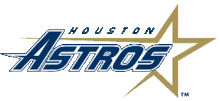

Off the field, in 1994, the Astros hired one of the first African American general managers, former franchise player Bob Watson. Watson would leave the Astros after the 1995 season to become general manager of the New York Yankees and helped to lead the Yankees to a World Championship in 1996. He would be replaced by Gerry Hunsicker, who until 2004 would continue to oversee the building of the Astros into one of the better and most consistent organizations in the Major Leagues.
However, in 1996, the Astros again nearly left Houston. By the mid-1990s, McLane (like McMullen before him) wanted his team out of the Astrodome and was asking the city to build the Astros a new stadium. When things did not progress quickly toward that end, he put the team up for sale. He had nearly finalized a deal to sell the team to businessman William Collins, who planned to move them to Northern Virginia. However, Collins was having difficulty finding a site for a stadium himself, so Major League owners stepped in and forced McLane to give Houston another chance to grant his stadium wish. Houston voters responded positively via a stadium referendum and the Astros stayed put.
2000-2004: New stadium

The 2000 season saw a move to a new stadium. Originally called Enron Field, the stadium was to feature a functional retractable roof, a particularly useful feature with unpredictable Houston weather. The ballpark also featured more intimate surroundings than the Astrodome. In 2002, naming rights were purchased by Houston-based Minute Maid, after Enron went bankrupt. The park was built on the grounds of the old Union Station. A locomotive moves across the outfield and whistles after home runs, paying homage to a Houston history which had eleven railroad company lines running through the city by 1860. The ballpark also contains quirks such as "Tal's Hill", which is a hill in deep center field on which a flagpole stands, all in fair territory. A similar feature was located in Crosley Field. Over the years, many highlight reel catches have been made by center fielders running up the hill to make catches. With the change in location also came a change in attire. Gone were the blue and gold uniforms of the 1990s in favor a more "retro" look with pinstripes, a traditional baseball font, and the colors of brick red, sand and black. The "shooting star" logo was modified but still retained its definitive look.
After two fairly successful seasons without a playoff appearance, the Astros were early favorites to win the 2004 NL pennant. They added star pitcher Andy Pettitte to a roster that already included standouts like Lance Berkman and Jeff Kent as well as veterans Bagwell and Biggio. Roger Clemens, who had retired after the 2003 season with the New York Yankees, agreed to join former teammate Pettitte on the Astros for 2004. The one-year deal included unique conditions, such as the option for Clemens to stay home in Houston on select road trips when he wasn't scheduled to pitch. Despite the early predictions for success, the Astros had a mediocre 44–44 record at the All-Star break. A lack of run production and a poor record in close games were major issues. After being booed at the 2004 All-Star Game held in Houston, manager Jimy Williams was fired and replaced by Phil Garner, a star on the division-winning 1986 Astros. The Astros enjoyed a 46–26 record in the second half of the season under Garner and earned the NL wild card spot. The Astros defeated the Braves 3-2 in the Division Series, but would lose the National League Championship Series to the St. Louis Cardinals in seven games. Clemens earned a record seventh Cy Young Award in 2004. Additionally, the mid-season addition of Carlos Beltrán in a trade with the Kansas City Royals helped the Astros tremendously in their playoff run. Despite midseason trade rumors, Beltrán would prove instrumental to the team's hopes, hitting eight home runs in the postseason. Though he had asserted a desire to remain with the Astros, Beltrán signed a long-term contract with the New York Mets on January 9, 2005.
2005: First World Series in Texas
In 2005, the Astros started poorly and found themselves with a 15-30 record in late May. The Houston Chronicle had written them off with a tombstone emblazened with "RIP 2005 Astros". However, from that low point until the end of July, Houston went 42–17 and found themselves in the lead for an NL wild card spot. July saw the best single month record in the club's history at 22-7. Offensive production had increased greatly after a slow start in the first two months. The Astros had also developed an excellent pitching staff, anchored by Roy Oswalt (20–12, 2.94), Andy Pettitte (17–9, 2.39), and Roger Clemens (13–8 with a league-low ERA of only 1.87). The contributions of the other starters - Brandon Backe (10–8, 4.76) and rookie starters Ezequiel Astacio (3–6, 5.67) and Wandy Rodríguez (10–10, 5.53) - were less remarkable, but enough to push the Astros into position for a playoff run. The Astros won a wild card berth on the final day of the regular season, becoming the first team since the world champion 1914 Boston Braves to qualify for the postseason after being 15 games under .500.
The Astros won the National League Division Series against the Atlanta Braves, 3-1, with a game four that set postseason records for most innings (18), most players used by a single team (23), and longest game time (5 hours and 50 minutes). Trailing by a score of 6-1, Lance Berkman hit an eighth inning grand slam to narrow the score to 6-5. In the bottom of the ninth, catcher Brad Ausmus, hit a game tying home run that allowed the game to continue in extra innings. In the bottom of the tenth inning, Luke Scott hit a blast to left field that had home run distance, but was inches foul. This game remained scoreless for the next eight innings. In the top of the fifteenth inning, Roger Clemens made only his second career relief appearance, pitching three shutout innings, notably striking out Julio Franco, at the time the oldest man in MLB at 47 years old. In the bottom of the eighteenth inning, Clemens came to bat again, indicating that he would be pitching in the nineteenth inning, if it came to that. Clemens struck out, swinging so hard that he injured a rib-cage muscle that would ultimately end the 2005 season for him. The next batter, Chris Burke, hit a home run to left field for the Astros win, 7−6. Oddly enough, a fan in the "Crawford Boxes" in left field had previously caught Berkman's grand slam and this same fan caught Burke's home run. The National League Championship Series featured a rematch of the 2004 NLCS. The Astros lost the first game in St. Louis, but would win the next three games, with Roy Oswalt getting the win. Though the Astros were poised to close out the series in Game Five in Houston, Brad Lidge gave up a monstrous two-out three-run home run to Albert Pujols, forcing the series to a sixth game in St. Louis, where the Astros clinched a World Series appearance. Roy Oswalt was named NLCS MVP, having gone 2−0 with a 1.29 ERA in the series. Current honorary NL President William Y. Giles presented the league champion Astros with the Warren C. Giles Trophy. Warren Giles, William's father and President of the National League from 1951 to 1969, had awarded an MLB franchise to the city of Houston in 1960.
The Astros faced the Chicago White Sox in the World Series. Chicago had been considered the slight favorite but would win all four games, the first two at U.S. Cellular Field in Chicago and the final two in Houston. Game 3 marked the first World Series game held in the state of Texas, and was the longest game in World Series history, lasting 5 hours and 41 minutes.
This World Series was marked by a controversy involving the Minute Maid Field roof. The White Sox owner insisted that since his team played in the open (they had no roof), the Astros must play with the roof open, which mitigated the intensity and enthusiasm of the cheering Astros fans.
2006-2010: The decline
In the 2006 offseason, the team signed Preston Wilson and moved Berkman to first base, ending the long tenure of Jeff Bagwell. The Astros renewed the contract with Clemens and traded two minor league prospects to the Tampa Bay Devil Rays for left-handed hitter Aubrey Huff. By August, Preston Wilson complained about his playing time after the return of Luke Scott from AAA Round Rock. The Astros released Wilson and he was signed by St. Louis. A dramatic season end included wins in 10 of their last 12 games, but the Astros missed a playoff appearance when they lost the final game of the season to the Atlanta Braves.
On October 31, the Astros declined a contract option on Jeff Bagwell for 2007, ending his 15-year Astros career and leading to his retirement. Roger Clemens and Andy Pettitte filed for free agency. On December 12, the Astros traded Willy Taveras, Taylor Buchholz, and Jason Hirsh to the Colorado Rockies for Rockies pitchers Jason Jennings and Miguel Asencio. A trade with the White Sox, involving the same three Astros in exchange for Jon Garland, had been nixed a few days earlier when Buchholz reportedly failed a physical. In the end, Taveras continued to develop and Hirsh had a strong 2007 rookie campaign, while Jennings was often injured and generally ineffective.
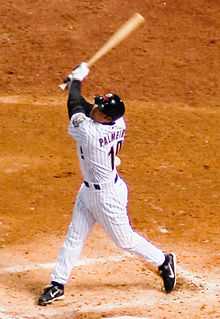
On April 28, 2007, the Astros purchased the contract of top minor league prospect Hunter Pence. He debuted that night, getting a hit and scoring a run. By May 2007, the Astros had suffered one of their worst recent losing streaks (10 games). On June 28, second baseman Craig Biggio became the 27th MLB player to accrue 3,000 career hits. Biggio needed three hits to reach 3,000 and on that night he had five hits. That night, Carlos Lee hit a towering walk-off grand slam in the eleventh inning. Lee later quipped to the newsmedia that "he had hit a walk-off grand slam and he got second billing", considering Biggio's achievement. On July 24, Biggio announced that he would retire at the end of the season. He hit a grand slam in that night's game which broke a 3–3 tie and led to an Astros win. In Biggio's last at bat, he grounded out to Chipper Jones of the Atlanta Braves.
On September 20, Ed Wade was named General Manager. In his first move, he traded Jason Lane to the Padres on September 24. On September 30, Craig Biggio retired after twenty years with the team. In November, the Astros traded RHP Brad Lidge and SS Eric Bruntlett to the Philadelphia Phillies for OF Michael Bourn, RHP Geoff Geary, and minor leaguer Mike Costanzo. Utility player Mark Loretta accepted Houston's salary arbitration and Kazuo Matsui finalized a $16.5 million, three-year contract with the team. In December the Astros traded OF Luke Scott, RHP Matt Albers, RHP Dennis Sarfate, LHP Troy Patton, and minor-league 3B Mike Costanzo, to the Baltimore Orioles for SS Miguel Tejada. On December 14, they sent infielder Chris Burke, RHP Juan Gutiérrez, and RHP Chad Qualls to the Arizona Diamondbacks for RHP José Valverde. On December 27, the Astros came to terms on a deal with All-star, Gold Glove winner Darin Erstad.
In January and February 2008, the Astros signed Brandon Backe, Ty Wigginton, Dave Borkowski and Shawn Chacón to one-year deals. The starting rotation would feature Roy Oswalt and Brandon Backe as numbers one and two. Wandy Rodríguez, Chacón and Chris Sampson rounded out the bottom three slots in the rotation. Woody Williams had retired after a 0−4 spring training and Jason Jennings was now with Texas. On the other side of the roster, the Astros would start without Kazuo Matsui, who was on a minor league rehab assignment after a spring training injury.
The Astros regressed in 2008 and 2009, finishing with records of 86−75 and 74−88, respectively. Manager Cecil Cooper was fired after the 2009 season.
2010−Present: Rock bottom: The franchise's first three 100 loss seasons
The 2010 season was the first season as Astros manager for Brad Mills, who was previously the bench coach of the Boston Red Sox. The Astros struggled throughout a season that was marked by trade-deadline deals that sent long time Astros to other teams. On July 29, the Astros' ace starting pitcher, Roy Oswalt, was dealt to the Philadelphia Phillies for J. A. Happ and two minor league players.[45][46] On July 31, outfielder Lance Berkman was traded to the New York Yankees for minor leaguers Jimmy Paredes and Mark Melancon.[47][48] The Astros finished with a record of 76-86.
On July 30, 2011, the Astros traded OF Hunter Pence, the team's 2010 leader in home runs, to the Philadelphia Phillies. On July 31, they traded OF Michael Bourn to the Atlanta Braves. On September 17, the Astros clinched their first 100-loss season in franchise history, On September 28, the Astros ended the season with an 8−0 home loss to the St. Louis Cardinals. Cardinals pitcher Chris Carpenter pitched a complete game, two-hit shutout in the game, enabling the Cardinals to win the National League Wild Card. The Astros finished with a record of 56−106, the worst single-season record in franchise history (a record which would be broken the following season).
In November 2010, Drayton McLane announced that the Astros were being put up for sale. McLane stated that because the Astros were one of the few franchises in Major League Baseball with only one family as the owners, he was planning his estate. McLane was 75 years old as of November 2011.[49] In March 2011, local Houston businessman Jim Crane emerged as the front-runner to purchase the franchise. In the 1980s, Crane founded an air freight business which later merged with CEVA Logistics, and later founded Crane Capital Group. McLane and Crane had a previous handshake agreement for the franchise in 2008, but Crane abruptly changed his mind and broke off discussions. Crane also attempted to buy the Chicago Cubs in 2008 and the Texas Rangers during their 2010 bankruptcy auction.[50] Crane came under scrutiny because of previous allegations of discriminatory hiring practices regarding women and minorities, among other issues. This delayed MLB's approval process. During the summer of 2011, a frustrated Crane hinted that the delays might threaten the deal.[51] In October 2011, Crane met personally with MLB Commissioner Bud Selig, in a meeting that was described as "constructive".[52]
On November 15, 2011, it was announced that Crane had agreed to move the franchise to the American League for the 2013 season. The move was part of an overall divisional realignment of MLB, with the National and American leagues each having 15 teams in three geographically balanced divisions. Crane was given a $70 million concession by MLB for agreeing to the switch; the move was a condition for the sale to the new ownership group.[53] Two days later, the Astros were officially sold to Crane after the other owners unanimously voted in favor of the sale.[54] It was also announced that 2012 would be the last season for the Astros in the NL.[55] After over fifty years of the Astros being a part of the National League, this move was unpopular with many Astros fans.[56][57]
In 2012, the Astros were eliminated from the playoffs before September 5. On September 27, the Astros named Bo Porter to be the manager for the 2013 season.
And, on October 3, the Astros ended over 50 years of NL play with a 5−4 loss to the Chicago Cubs. Winning only 20 road games during the entire season, the Astros finished with a 55−107 record, the worst record in all of Major League Baseball for the 2012 season, and surpassing the 2011 season for the worst record in Astros history.
On November 2, 2012, the Astros unveiled their new look in preparation for their move to the American League for the 2013 season. The uniform is navy blue and orange, going back to the original 1960s team colors, as well as debuting a new version of the classic navy blue hat with a white "H" over an orange star.[58]
On November 6, 2012, the Astros hired former Cleveland Indians director of baseball operations David Stearns as the team's new assistant general manager.[59] The Astros would also go on to hire former St Louis Cardinals front office executive Jeff Luhnow as their general manager. His analytics and reliance on scouts blends the science with the art of baseball and have accounted for the success that the Cardinals have had winning multiple championships over recent years.
The Houston Astros played their first game as an American League team on March 31, 2013, where they were victorious over their cross-state division rivals the Texas Rangers with a score of 8–2.
When the Astros were in the National League, their "permanent rival" for interleague play had been their in-state rivals, the American League's Texas Rangers. Starting in 2013, with the Astros move to the American League, their new permanent interleague rival is the Colorado Rockies.
And on September 29, the Astros completed their first year in the American League, losing 5−1 in a 14 inning game to the New York Yankees. The Astros finished the season with a 51−111 record (Astros worst season ever) with a season ending 15 game losing streak. This marks three consecutive years that the Astros have lost more than 100 games in a single season.
They became the first team to have the first overall pick in the draft three years in a row.
Achievements
List of Houston Astros Seasons
Awards
- Darryl Kile Award
- See: Houston Astros award winners and league leaders#Darryl Kile Award
Two awards are presented each year, one to a Houston Astro and one to a St. Louis Cardinal, each of whom exemplifies Kile's virtues of being "a good teammate, a great friend, a fine father and a humble man." The winner is selected by each local chapter of the Baseball Writers' Association of America.[60]
Team records
Retired numbers
|
While not officially retired, the Astros have not reissued number 57 since 2002, when former Astros pitcher Darryl Kile died as an active player with the St. Louis Cardinals, or the number 17 since 2010, in honor of Lance Berkman since his departure, when he was traded to the New York Yankees.[citation needed] The number 42 is retired by MLB in honor of Jackie Robinson
Hall of Fame
Baseball Hall of Fame members
| Houston Astros Hall of Famers | ||||||||||||||||||||||||||||||||||||
|---|---|---|---|---|---|---|---|---|---|---|---|---|---|---|---|---|---|---|---|---|---|---|---|---|---|---|---|---|---|---|---|---|---|---|---|---|
| Affiliation according to the National Baseball Hall of Fame and Museum | ||||||||||||||||||||||||||||||||||||
| ||||||||||||||||||||||||||||||||||||
Ford C. Frick Award recipients
| Houston Astros Ford C. Frick Award recipients | |||||||||
|---|---|---|---|---|---|---|---|---|---|
| Affiliation according to the National Baseball Hall of Fame and Museum | |||||||||
| |||||||||
Current roster
| Houston Astros 2014 spring training roster | |||||||||
|---|---|---|---|---|---|---|---|---|---|
| 40-man roster | Non-roster invitees | Coaches/Other | |||||||
|
Pitchers
|
Catchers
Infielders
Outfielders
|
Pitchers
Catchers
Infielders
Outfielders
|
Manager
Coaches
| ||||||
Minor league affiliations
Radio and television
As of 2013, the Astros' new flagship radio station is KBME, Sportstalk 790AM (a Fox Sports Radio affiliate), leaving KTRH, 740AM after a partnership with them since 1999 (both stations are owned by Clear Channel Communications). This change suddenly made it difficult for listeners outside of Houston itself to hear the Astros, as KTRH runs fifty kilowatts of power day and night, and KBME runs only five kilowatts. As a result, KTRH is audible across much of Central, East, and South Texas, whereas KBME can only be heard in Houston, especially after dark. Milo Hamilton, a veteran voice who was on the call for Hank Aaron's 715th career home run in 1974, retired at the end of the 2012 season, after broadcasting play-by-play for the Astros since 1985. Dave Raymond and Brett Dolan shared play-by play duty for road games, while Raymond additionally worked as Hamilton's color analyst (while Hamilton called home games only for the past few seasons before his retirement); they were not retained and instead brought in Robert Ford and Steve Sparks to begin broadcasting for the 2013 season.[61]
Spanish language radio play-by-play is handled by Francisco Romero, and his play-by-play partner is Alex Treviño, a former backup catcher for the club.
During the 2012 season Astros games on television were announced by Bill Brown and Jim Deshaies. Until the 2012 season, Astros games were broadcast on television by Fox Sports Houston, with select games shown on broadcast TV by KTXH. As part of a ten-year, $1 billion deal with Comcast that includes a majority stake jointly held by the Astros and the Houston Rockets, Houston Astros games will move to the new Comcast SportsNet Houston at the beginning of the 2013 season.[62] On September 27, 2013 CSN Houston filed for Chapter 11 Bankruptcy and surprising the Astros who own the largest stake.[63]
The 2013 television team will consist of Bill Brown and Alan Ashby.
Uniforms
-

Houston Astros home uniform, 2013-current -

Houston Astros away uniform, 2013-current
Mascots
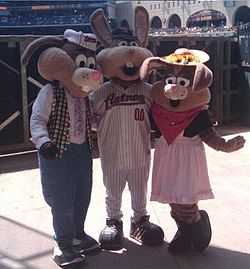
The Astros had been represented by a trio of rabbit mascots named Junction Jack, Jesse and Julie from 2000 through 2012.[citation needed]
On November 2, 2012, the Astros announced the return of the mascot Orbit, a lime-green outer-space creature that the team employed from 1990 through 1999.
References
- General
- A Six-Gun Salute: An Illustrated History of the Houston Colt .45s, by Robert Reed (Rowman-Littlefield Publishing, Boston, 1999)
- In-line citations
- ↑ "Astros Headed to American League as New Team Owner Approved". Businessweek.com. 2011-11-18. Retrieved 2012-11-05.
- ↑ "Minute Maid Park | astros.com: Ballpark". Houston.astros.mlb.com. Retrieved 2012-11-05.
- ↑ Elston, Gene. "George Kirksey Papers". Houston Chronicle. Retrieved 2008-09-26.
- ↑ 4.0 4.1 4.2 4.3 4.4 4.5 4.6 4.7 4.8 4.9 4.10 4.11 4.12 4.13 4.14 "The Colt .45s". AstrosDaily. Retrieved 2008-09-26.
- ↑ "Russell Drops Plans to Buy Buff Franchise". Bonham Daily Favorite. January 24, 1960. Retrieved 2012-12-06.
- ↑ "New York-Houston Get National Franchises". Lodi News-Sentinel. October 11, 1960.
- ↑ "Houston Baseball Muddled for '61". The Victoria Advocate. 1960-10-21. Retrieved 2013-03-25.
- ↑ "Houston Will Get Emphasis, Paul Declares". Observer–Reporter. 1961-01-19. Retrieved 2013-03-25.
- ↑ Herskowitz, Mickey (2005-10-24). "Astros out to make history their history". Houston Astros. Retrieved 2008-10-01.
- ↑ Ian, Fleming (2006-05-10). "April 10, 1962 Chicago Cubs at Houston Colt .45's Play by Play and Box Score". Sports Reference. Retrieved 2011-08-04.
- ↑ Coons, Ron (2006-05-10). "Richard "Turk" Farrell". find a grave. Retrieved 2008-10-02.
- ↑ "Jim Umbricht Incredible-people.com". Profiles.incredible-people.com. Retrieved 2012-11-05.
- ↑ "Astrodome Houston-Astros.com". Houston.astros.mlb.com. Retrieved 2012-11-05.
- ↑ Ballparksofbaseball.com
- ↑ 15.0 15.1 Jimmy Wynn Statistics – Baseball-Reference.com
- ↑ "Baseball-Reference.com". Retrieved 2012-11-05.
- ↑ "The Ballplayers - Cesar Cedeno". BaseballLibrary.com. 1985-08-29. Retrieved 2012-11-05.
- ↑ 18.0 18.1 18.2 18.3 18.4 18.5 18.6 18.7 18.8 18.9 18.10 "Astros History". Astrosdaily.com. Retrieved 2012-11-05.
- ↑ "Cesar Cedeno Statistics and History". Baseball-Reference.com. Retrieved 2012-11-05.
- ↑ 20.0 20.1 Treder, Steve. "Offseason blockbusters: November (Part two: 1966-1981)". Hardball Times.
- ↑ "Lee May Baseball Stats, facts, biography, images and video.". The Baseball Page. Retrieved 2012-11-05.
- ↑ "Hofheinz, Roy Mark tshonline.org". Tshaonline.org. Retrieved 2012-11-05.
- ↑ "Interview - Tal Smith - Pres. Baseball Ops - Astros". Bizofbaseball.com. 2005-10-09. Retrieved 2012-11-05.
- ↑ "The Ballplayers - Enos Cabell". BaseballLibrary.com. Retrieved 2012-11-05.
- ↑ "The Ballplayers - Joe Niekro". BaseballLibrary.com. Retrieved 2012-11-05.
- ↑ Cardinals Encyclopedia - Michael Eisenbath - Google Boeken. Books.google.com. 1999-05-14. ISBN 9781566397032. Retrieved 2012-11-05.
- ↑ "1976 Houston Astros Batting, Pitching, & Fielding Statistics". Baseball-Reference.com. Retrieved 2012-11-05.
- ↑ "Joe Niekro Statistics and History". Baseball-Reference.com. Retrieved 2012-11-05.
- ↑
- ↑ "1979 Houston Astros Trades and Transactions". Baseball-Reference.com. Retrieved 2012-11-05.
- ↑ Goldstein, Richard (September 18, 2005). "John J. McMullen Dies at 87; Ex-Owner of Devils and Astros". The New York Times.
- ↑ "Joe Morgan - Playing With Houston - Player, League, Baseball, and Valuable - JRank Articles". Sports.jrank.org. Retrieved 2012-11-05.
- ↑ "Video". CNN. August 18, 1980.
- ↑ "One-game playoff history - MLB - ESPN". Sports.espn.go.com. 2007-09-30. Retrieved 2012-11-05.
- ↑ "Baseball's Best | MLB.com: Programming". Mlb.mlb.com. Retrieved 2012-11-05.
- ↑ "Baseball's Best | MLB.com: Programming". Mlb.mlb.com. Retrieved 2012-11-05.
- ↑ "Bill Doran Statistics and History". Baseball-Reference.com. Retrieved 2012-11-05.
- ↑ "Hal Lanier Statistics and History". Baseball-Reference.com. Retrieved 2012-11-05.
- ↑ "Whitey Ball". Hardballtimes.com. Retrieved 2012-11-05.
- ↑ "1986 Houston Astros Batting, Pitching, & Fielding Statistics". Baseball-Reference.com. Retrieved 2012-11-05.
- ↑ "Real Insight. Real Fans. Real Conversations". Sporting News. Retrieved 2012-11-05.
- ↑ "1986 Houston Astros Schedule by Baseball Almanac". Baseball-almanac.com. Retrieved 2012-11-05.
- ↑ "Houston Astros history - 1987 season". Astrosdaily.com. Retrieved 2012-11-05.
- ↑ Haller, Dave (October 20, 2005). "Prospectus Notebook: Astros, Blue Jays". Baseball Prospectus. Retrieved March 8, 2012.
- ↑ "Source: Oswalt headed to Phillies".
- ↑ "Oswalt accepts trade to Phillies".
- ↑ "Yankees make Berkman Deal Official". Yankees.lhblogs.com. July 31, 2010. Retrieved July 31, 2010.
- ↑ McTaggart, Brian (July 30, 2010). "Astros finalize Berkman deal with Yankees". Pressbox.mlb.com. Retrieved July 30, 2010.
- ↑ (2010-11-19). "Owner Drayton McLane officially puts the Houston Astros up for sale | abc13.com". Abclocal.go.com. Retrieved 2012-11-05.
- ↑ "McLane 'close' in deal to sell Astros to Jim Crane - Houston Chronicle". Chron.com. 2011-03-25. Retrieved 2012-11-05.
- ↑ "Frustrated Jim Crane ‘offended’ by speculation about delays in Astros sale process". Blog.chron.com. 2011-09-08. Retrieved 2012-11-05.
- ↑ Levine, Zachary (October 10, 2011). "Jim Crane has ‘constructive’ meeting with Bud Selig". Houston Chronicle. Retrieved February 24, 2012.
- ↑ "Houston Astros To The American League: MLB Gives New Owner A $70 Million Discount, According To Reports". SB Nation. Retrieved February 24, 2012.
- ↑ "Sale of Astros to Jim Crane, move to American League in 2013 approved | astros.com: News". Houston.astros.mlb.com. Retrieved 2012-11-05.
- ↑ "Astros bring welcome change to American League West | astros.com: News". Houston.astros.mlb.com. Retrieved 2012-11-05.
- ↑ "Astros' sale finalized; 2 more for playoffs". ESPN.com. November 18, 2011. Retrieved February 24, 2012.
- ↑ Campbell, Steve (November 16, 2011). "Local attorney says Astros’ move to AL violates lease agreement". Houston Chronicle (Ultimate Astros blog). Retrieved February 24, 2012.
- ↑ "Astros announce launch event to show off new look | astros.com: News". Houston.astros.mlb.com. Retrieved 2012-11-05.
- ↑ "Stearns hired as Astros' assistant GM". Yahoo! Sports. 2012-11-06. Retrieved 2012-11-06.
- ↑ Darryl Kile Award. Baseball Almanac. Retrieved 2010-07-02.
- ↑ Robert Ford, Steve Sparks Announced As Astros Radio Team - The Crawfish Boxes
- ↑ "Comcast SportsNet Houston plans October launch". Houston Chronicle. Retrieved 13 November 2012.
- ↑ CSN Houston bankruptcy filing surprises Astros - Sports Update
External links
| Wikimedia Commons has media related to Houston Astros. |
- Official website
- Houston Astros news from the Houston Chronicle
- Astros team page on Baseball-Reference.com
- Houston Astros Video on ESPN Video Archive
- Houston Astros history
| Preceded by St. Louis Cardinals 2004 |
National League Champions Houston Astros 2005 |
Succeeded by St. Louis Cardinals 2006 |
| |||||||||||||||||||||||||||||||||||||||||||||||||||
| |||||
| |||||
| Houston Astros franchise | |||
|---|---|---|---|
| Triple-A | Double-A | Class A | Rookie |
| Oklahoma City RedHawks | Corpus Christi Hooks |
Lancaster JetHawks Quad Cities River Bandits Tri-City ValleyCats |
Greeneville Astros GCL Astros DSL Astros |
| |||||||||||||||||||||||||
| |||||||||||||||||||||||||
| ||||||||||||||||||||||


